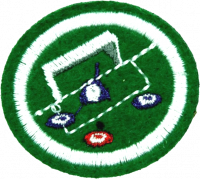Difference between revisions of "AY Honors/Button Football/Answer Key/es"
From Pathfinder Wiki
< AY Honors | Button FootballAY Honors/Button Football/Answer Key/es
(Created page with "{{clear}}") |
(Updating to match new version of source page) |
||
| (13 intermediate revisions by one other user not shown) | |||
| Line 1: | Line 1: | ||
| − | + | {{HonorSubpage}} | |
| − | |||
| − | {{ | ||
| − | |||
| − | |||
| − | |||
| − | |||
| − | |||
| − | |||
| − | |||
| − | |||
| − | |||
| − | |||
| − | |||
<section begin="Body" /> | <section begin="Body" /> | ||
{{ansreq|page={{#titleparts:{{PAGENAME}}|2|1}}|num=1}} | {{ansreq|page={{#titleparts:{{PAGENAME}}|2|1}}|num=1}} | ||
| Line 20: | Line 7: | ||
{{clear}} | {{clear}} | ||
| − | + | {{clear}} | |
| − | + | {{clear}} | |
<noinclude></noinclude> | <noinclude></noinclude> | ||
| Line 36: | Line 23: | ||
<!-- 3. Conocer y explicar algunas reglas básicas antes de comenzar un partido de fútbol de botones. --> | <!-- 3. Conocer y explicar algunas reglas básicas antes de comenzar un partido de fútbol de botones. --> | ||
| − | |||
| − | + | {{clear}} | |
| − | + | {{clear}} | |
| − | + | {{clear}} | |
| − | + | {{clear}} | |
| − | + | {{clear}} | |
| + | |||
| + | {{clear}} | ||
| − | + | {{clear}} | |
<noinclude></noinclude> | <noinclude></noinclude> | ||
| Line 58: | Line 46: | ||
[[File:Bfpieces.png|right|Pelotas, botones y piezas típicas]] | [[File:Bfpieces.png|right|Pelotas, botones y piezas típicas]] | ||
| − | + | {{clear}} | |
| − | + | {{clear}} | |
| − | + | {{clear}} | |
| − | + | {{clear}} | |
<noinclude></noinclude> | <noinclude></noinclude> | ||
| Line 156: | Line 144: | ||
[[Category:Adventist Youth Honors Answer Book/es]] | [[Category:Adventist Youth Honors Answer Book/es]] | ||
<noinclude></noinclude> | <noinclude></noinclude> | ||
| − | + | {{CloseHonorPage}} | |
Latest revision as of 17:46, 25 May 2021
Fútbol de botones
Nivel de destreza
1
Año
2012
Version
06.01.2026
Autoridad de aprobación
División Sudamericana
1
Definir qué es fútbol de botones. Contar una breve historia de cómo surgió este deporte.
2
Saber por lo menos dos modalidades que podemos practicar con el fútbol de botones.
3
Conocer y explicar algunas reglas básicas antes de comenzar un partido de fútbol de botones.
4
Hacer una lista de los equipos necesarios para la realización de un partido de fútbol de botón.
5
Citar algunos tipos de materias primas que pueden usarse en la fabricación de un botón.
6
Describir los siguientes términos en el fútbol de botones:
6a
Botonista
6b
Gol marcado
6c
Jugada de tres
6d
Ley de la ventaja
6e
Lateral
6f
Penal
6g
Tiro libre directo e indirecto
6h
Falta
6i
Pelota presionada
7
¿Cuál es el tiempo promedio de la duración de un partido de fútbol de botones?
8
¿Cuál es la medida oficial de la mesa para el fútbol de botones? Hacer un diagrama demostrativo de la cancha, citando las marcaciones y medidas que son obligatorias para la realización de este juego.
9
Hacer y confeccionar un equipo completo de fútbol de botones, con cualquier material de tu elección. Diseñar un emblema de identificación para su equipo.
10
Participar por lo menos de un partido o inscribirse en una competencia de fútbol de botón organizada por tu región, haciendo un breve informe de lo que ocurrió en el(los) juego(s).





